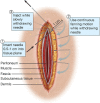Surgical Site Infiltration for Abdominal Surgery: A Novel Neuroanatomical-based Approach
- PMID: 28293525
- PMCID: PMC5222670
- DOI: 10.1097/GOX.0000000000001181
Surgical Site Infiltration for Abdominal Surgery: A Novel Neuroanatomical-based Approach
Abstract
Background: Provision of optimal postoperative analgesia should facilitate postoperative ambulation and rehabilitation. An optimal multimodal analgesia technique would include the use of nonopioid analgesics, including local/regional analgesic techniques such as surgical site local anesthetic infiltration. This article presents a novel approach to surgical site infiltration techniques for abdominal surgery based upon neuroanatomy.
Methods: Literature searches were conducted for studies reporting the neuroanatomical sources of pain after abdominal surgery. Also, studies identified by preceding search were reviewed for relevant publications and manually retrieved.
Results: Based on neuroanatomy, an optimal surgical site infiltration technique would consist of systematic, extensive, meticulous administration of local anesthetic into the peritoneum (or preperitoneum), subfascial, and subdermal tissue planes. The volume of local anesthetic would depend on the size of the incision such that 1 to 1.5 mL is injected every 1 to 2 cm of surgical incision per layer. It is best to infiltrate with a 22-gauge, 1.5-inch needle. The needle is inserted approximately 0.5 to 1 cm into the tissue plane, and local anesthetic solution is injected while slowly withdrawing the needle, which should reduce the risk of intravascular injection.
Conclusions: Meticulous, systematic, and extensive surgical site local anesthetic infiltration in the various tissue planes including the peritoneal, musculofascial, and subdermal tissues, where pain foci originate, provides excellent postoperative pain relief. This approach should be combined with use of other nonopioid analgesics with opioids reserved for rescue. Further well-designed studies are necessary to assess the analgesic efficacy of the proposed infiltration technique.
Figures




Similar articles
-
Surgical site infiltration: A neuroanatomical approach.Best Pract Res Clin Anaesthesiol. 2019 Sep;33(3):317-324. doi: 10.1016/j.bpa.2019.07.017. Epub 2019 Jul 25. Best Pract Res Clin Anaesthesiol. 2019. PMID: 31785717 Review.
-
Effectiveness of ondansetron as an adjunct to lidocaine intravenous regional anesthesia on tourniquet pain and postoperative pain in patients undergoing elective hand surgery: a systematic review protocol.JBI Database System Rev Implement Rep. 2015 Jan;13(1):27-38. doi: 10.11124/jbisrir-2015-1768. JBI Database System Rev Implement Rep. 2015. PMID: 26447005
-
Best Practices for Periarticular Infiltration With Liposomal Bupivacaine for the Management of Pain After Shoulder Surgery: Consensus Recommendation.J Surg Orthop Adv. 2016 Winter;25(4):204-208. J Surg Orthop Adv. 2016. PMID: 28244860 Review.
-
Updates on Wound Infiltration Use for Postoperative Pain Management: A Narrative Review.J Clin Med. 2021 Oct 11;10(20):4659. doi: 10.3390/jcm10204659. J Clin Med. 2021. PMID: 34682777 Free PMC article. Review.
-
Infiltration Techniques for Local Infiltration Analgesia With Liposomal Bupivacaine in Extracapsular and Intracapsular Hip Fracture Surgery: Expert Panel Opinion.J Orthop Trauma. 2018 Aug;32 Suppl 2:S5-S10. doi: 10.1097/BOT.0000000000001227. J Orthop Trauma. 2018. PMID: 30028758
Cited by
-
Inappropriate manipulation and drainage exacerbate post-operative pain and prolong the hospital stay after laparoscopic appendectomy for pediatric complicated appendicitis.BMC Surg. 2021 Dec 25;21(1):437. doi: 10.1186/s12893-021-01413-x. BMC Surg. 2021. PMID: 34953485 Free PMC article.
-
Extended Release of Bupivacaine from Temperature-Responsive PNDJ Hydrogels Improves Postoperative Weight-Bearing in Rabbits Following Knee Surgery.Pharmaceuticals (Basel). 2024 Jul 3;17(7):879. doi: 10.3390/ph17070879. Pharmaceuticals (Basel). 2024. PMID: 39065729 Free PMC article.
-
Enhanced Recovery After Surgery Pathway in Kidney Transplantation: The Road Less Traveled.Transplant Direct. 2022 Jun 17;8(7):e1333. doi: 10.1097/TXD.0000000000001333. eCollection 2022 Jul. Transplant Direct. 2022. PMID: 35747520 Free PMC article.
-
An injectable oleogel-based bupivacaine formulation for prolonged non-opioid post-operative analgesia.Drug Deliv Transl Res. 2025 Apr;15(4):1424-1443. doi: 10.1007/s13346-024-01688-6. Epub 2024 Aug 6. Drug Deliv Transl Res. 2025. PMID: 39107674
-
Use of Muscle Relaxants for Acute Postoperative Pain: A Practical Review.Plast Reconstr Surg Glob Open. 2024 Jul 1;12(7):e5938. doi: 10.1097/GOX.0000000000005938. eCollection 2024 Jul. Plast Reconstr Surg Glob Open. 2024. PMID: 38957722 Free PMC article. Review.
References
-
- Gustafsson UO, Scott MJ, Schwenk W, et al. Enhanced Recovery After Surgery (ERAS) Society, for Perioperative Care; European Society for Clinical Nutrition and Metabolism (ESPEN); International Association for Surgical Metabolism and Nutrition (IASMEN) Guidelines for perioperative care in elective colonic surgery: Enhanced Recovery After Surgery (ERAS(®)) Society recommendations. World J Surg. 2013;37:259–284. - PubMed
-
- Joshi GP, Schug SA, Kehlet H. Procedure-specific pain management and outcome strategies. Best Pract Res Clin Anaesthesiol. 2014;28:191–201. - PubMed
-
- Oderda GM, Gan TJ, Johnson BH, et al. Effect of opioid-related adverse events on outcomes in selected surgical patients. J Pain Palliat Care Pharmacother. 2013;27:62–70. - PubMed
-
- Rackelboom T, Le Strat S, Silvera S, et al. Improving continuous wound infusion effectiveness for postoperative analgesia after cesarean delivery: a randomized controlled trial. Obstet Gynecol. 2010;116:893–900. - PubMed
-
- Rozen WM, Tran TM, Ashton MW, et al. Refining the course of the thoracolumbar nerves: a new understanding of the innervation of the anterior abdominal wall. Clin Anat. 2008;21:325–333. - PubMed
LinkOut - more resources
Full Text Sources
Other Literature Sources
